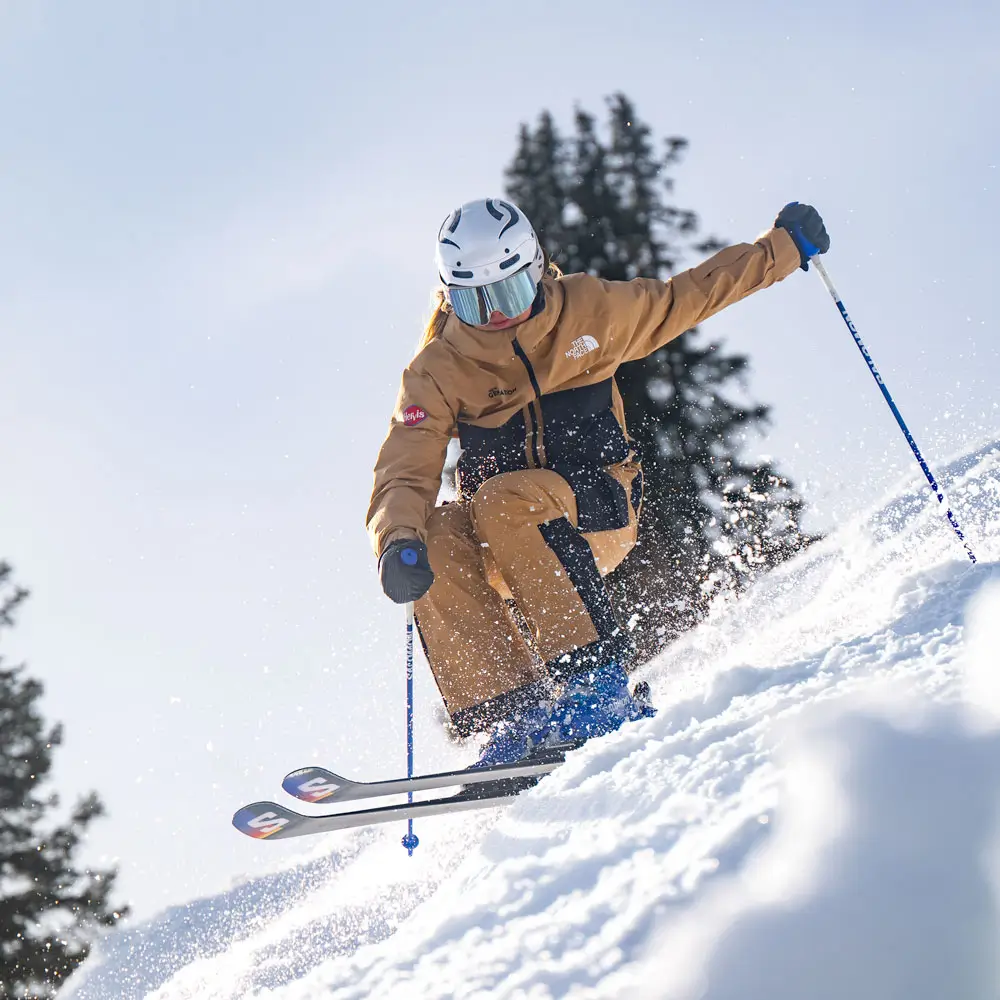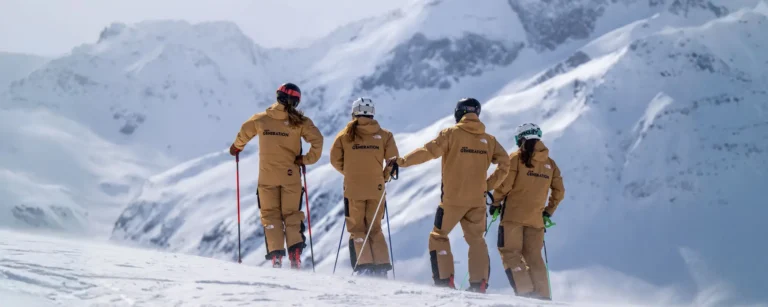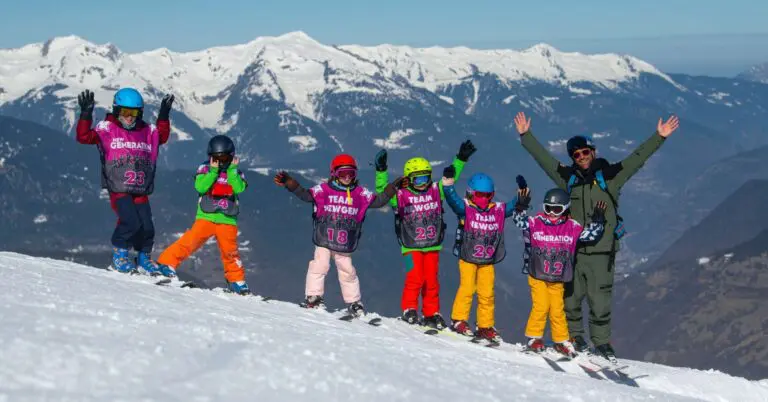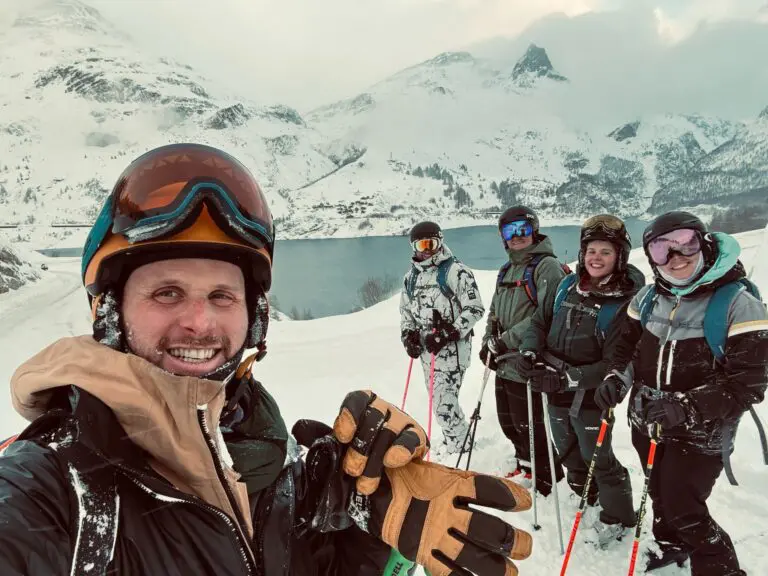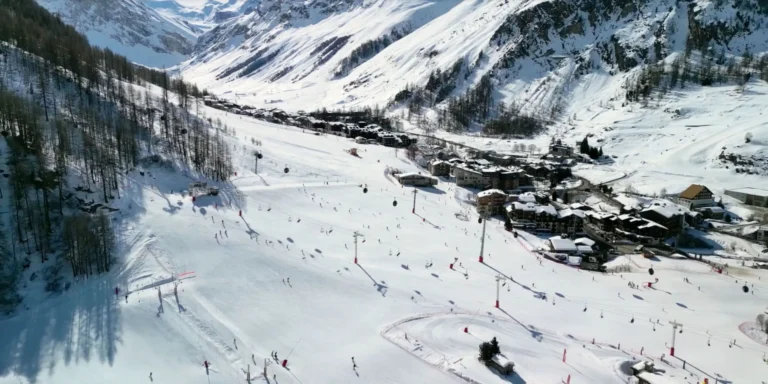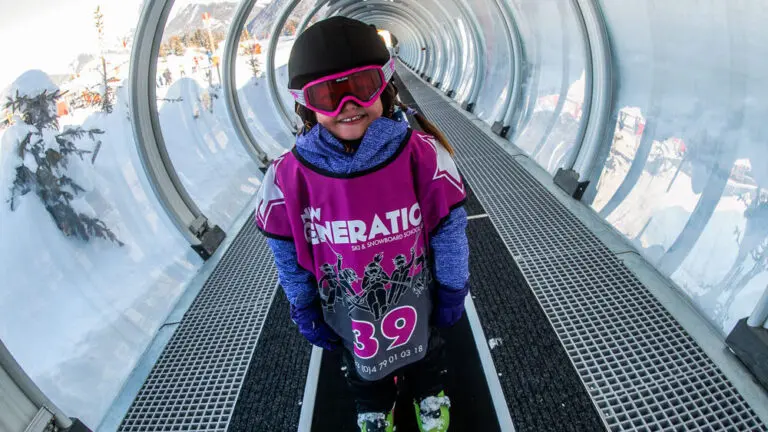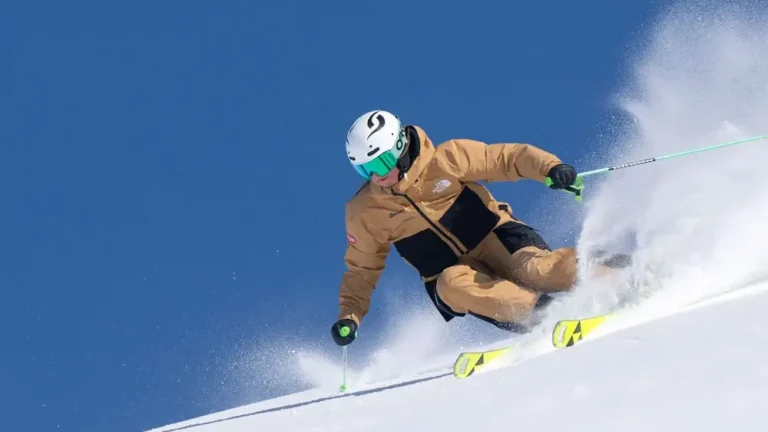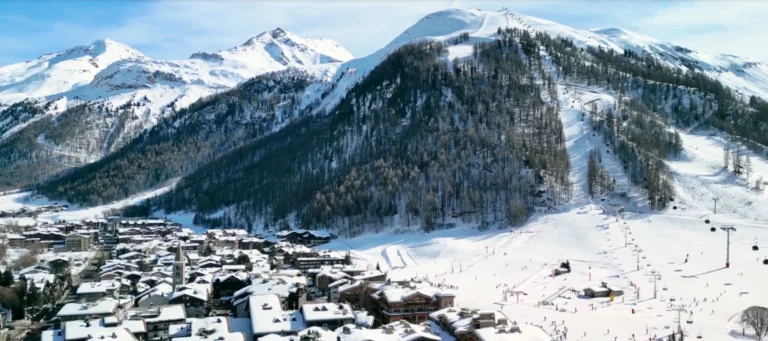Introduction
Embarking on a gap year ski season is an exciting way to spend a winter in the mountains. Instead of a brief holiday, you get to immerse yourself in the alpine lifestyle for months. Improving your skiing or snowboarding. Experiencing mountain culture. And possibly even kickstarting a snowsports career. You can take many paths during the ski season, from working jobs at the resort to skiing every day. This guide includes everything you need to know about gap year skiing—from training options and job roles to destinations, qualifications and financial planning.
What’s a gap year ski season?
A Gap Year Ski Season is a dedicated period—typically during a gap year between school and university, university and employment, or during a career break—spent working, training, or skiing full-time in a ski resort. It’s an immersive experience that combines travel, sport, and personal growth.
Top gap year ski destinations and programs
European Alps – Classic gap year experience
A gap year ski season can be done in many parts of the world. Here are some of the most popular regions and what they offer:
- France:, Tignes, , Meribel
Ideal for gap year ski season France seekers—top-tier terrain and strong demand for English-speaking instructors.
Known for its vibrant ski and après-ski culture.
- Switzerland: Verbier, Zermatt, St. Moritz
High-end resorts offering luxury hospitality and elite skiing environments.
>>Check out our Ski Schools in the European Alps.
Canada and the USA
North America, particularly Canada, is a popular choice for gap years. Resorts like Whistler and Banff offer excellent snow and terrain, with working holiday programs available. A perk of working at a ski mountain is the free season lift pass. The community is welcoming, and English is widely spoken. The U.S. also has top resorts like Vail and Aspen, but finding seasonal work can be tougher for foreigners. Ski seasons typically run from November/December to April.
Japan
It is renowned for its deep powder snow, especially in Hokkaido, home to popular resorts like Niseko and Hakuba that attract experienced skiers from around the world. The atmosphere tends to be more mature, focusing on early mornings for fresh tracks rather than wild après-ski parties, although there’s still plenty to enjoy. It offers a unique cultural experience, and many foreigners work as instructors or in hospitality roles (English speakers are in demand). The ski season typically runs from December to March.
Southern Hemisphere
New Zealand is a top destination, with its ski season running from June to October, especially around Queenstown and Wanaka (Treble Cone, Cardrona). Australia also has ski fields like Perisher and Thredbo, along with resorts in South America in Argentina and Chile, like Cerro Catedral in Bariloche and Cerro Castor in Ushuaia, that attract adventurous skiers. Many gap-year skiers work a season in Europe or Canada before heading to New Zealand or South America. Remember that job availability and hiring seasons will vary by country.
Working a ski season: Job options
Most gap year ski season travellers offset their costs by working at the resort. A job means earning money (or at least room and board) while living in the mountains. It also gives you a built-in social circle with fellow staff. Here are standard job options for ski seasons, with their key features:
- Chalet Host / General Hospitality:
- Duties: Cooking, cleaning, and guest care in chalets or hotels.
- Perks: Often includes accommodation, meals, and a season pass.
- Pros: Low living costs, solid hospitality experience, strong team environment.
- Cons: Early mornings, long hours, limited ski time, missing après-ski, and physically demanding.
- Bar Staff / Waiter:
- Duties: Working in bars, pubs, or restaurants, mostly in the evenings.
- Pros: Social job, good tips (especially in North America), ski during the day.
- Cons: Late nights, tiring after skiing, fewer jobs available, and not always with accommodation.
- Lift Operator (“Lifty”):
- Duties: Operating lifts, assisting skiers, and shovelling snow.
- Pros: On-mountain all day, good ski access, often includes lift pass and housing.
- Cons: Repetitive, cold, sometimes lonely. Hard to get in Europe for non-EU citizens – easier in Canada, NZ, or Australia.
- Childcare/Nanny:
- Duties: Looking after children while parents ski, indoors or outdoors.
- Pros: Rewarding if you like kids, relaxed evenings, usually includes lodging and lift pass.
- Cons: Little or no ski time, needs experience or qualifications, variable demand.
- Ski or Snowboard Instructor:
- Duties: Teaching skiing or snowboarding after gaining certification.
- Pros: Ski daily for work, good pay, social instructor community, long-term career potential.
- Cons: Upfront training costs, limited free skiing, usually no accommodation included.
>> Read more: How much do ski instructors make?
Find out more about our Ski Instructor Courses here.
- Other Resort Jobs:
- Examples: Chefs, drivers, retail/rental staff, ski patrol, mountain guides, resort reps.
- Requirements: Vary by role – some need certifications or prior experience.
- Highlights: Great for those with specific skills (cooking, driving, guiding and customer service).
Skiing without working: Earning ski instructor qualifications or the ski-bum life
Not everyone who takes a gap year ski season needs or wants to work during their time in the mountains. If you have the savings (or other support), you can focus entirely on skiing and snowboarding. Two main non-work paths exist: joining a ski or snowboard course or simply being a ski bum, travelling and riding for fun. Here’s an overview of these options:
1. Instructor or improvement courses
Structured ski or snowboard courses are popular for those who want to focus on skills and career progression without..
Types of courses
- Instructor Certification Courses: Typically 8–12 weeks to gain Level 1 or Level 2 instructor qualifications.
- Performance Improvement / All-Mountain Courses: Focus on technique, freeride, park skills, or all-round skiing development.
Key features
- Daily coaching from experienced pros.
- Accommodation, meals, and a lift pass are often included in the package.
- Social perks: You join a community of like-minded people, creating strong friendships.
- Career potential: Certification can lead to future job opportunities as an instructor.
Pros
- Massive skill improvement.
- Structured training and a supportive group.
- High ski volume – you’re on snow most days.
- Hassle-free logistics.
Cons
- Expensive – requires significant savings or funding.
- No income during the course (unless it’s part of a “train-then-work” program).
- Commitment required – it’s intensive and not as laid-back as free skiing.
2. The “Ski Bum” lifestyle
For those craving total freedom, the ski bum path offers a no-rules, all-fun approach: live in a ski town simply to ski as much as possible, without formal work.
What it looks like
- Spend your savings to live at or travel between ski resorts.
- Wake up late or chase powder whenever you want.
- Dive into the local scene – skiing by day, après-ski by night.
Pros
- Ultimate freedom – no schedules, bosses, or responsibilities.
- Ski every day on your terms.
- Experience multiple resorts if you choose to travel.
- Opportunity for personal growth through spontaneity and independence.
Cons
- High costs – lift passes, rent, gear, food, and drinks quickly add up.
- No built-in social group – you’ll need to be proactive to make friends.
- Limited structure – if you thrive on goals or training, it might feel aimless.
- Financial strain – unless you’ve budgeted well or have backup funds.
Tips
- Stay in social accommodations like hostels or shared apartments.
- Join group lessons or social ski events to meet people.
- Consider casual or gig work (flyer distribution, temp jobs) if needed.
Flexible approach
Some combine both lifestyles:
- Do a course, then ski bum.
- Work part of the season, then take time off.
- Mix casual gigs with free skiing.
Why choose a ski instructor gap year over traditional options?
Adventure meets professional development
Gap-year skiing isn’t just about fun—it’s a unique combination of training and adventure that builds personal and professional competencies. With daily instruction, assessments, and on-snow practice, you’ll develop teaching, communication, and technical skills in a dynamic, challenging environment.
Earning while learning in stunning locations
One of the standout perks of a gap year ski season job is getting paid to do what you love. After qualifying, you can secure roles like ski instructor or chalet host—earning while living among snow-covered peaks.
Building confidence and independence
A ski year abroad demands responsibility, adaptability, and independence. Whether navigating international travel, living communally, or dealing with guests and colleagues, you’ll develop resilience and confidence—skills that translate far beyond the slopes.
Creating a global network of friends and contacts
You’ll meet people from all walks of life—future colleagues, lifelong friends, and mentors. The gap year in the Alps attracts a mix of adventurers and professionals worldwide.
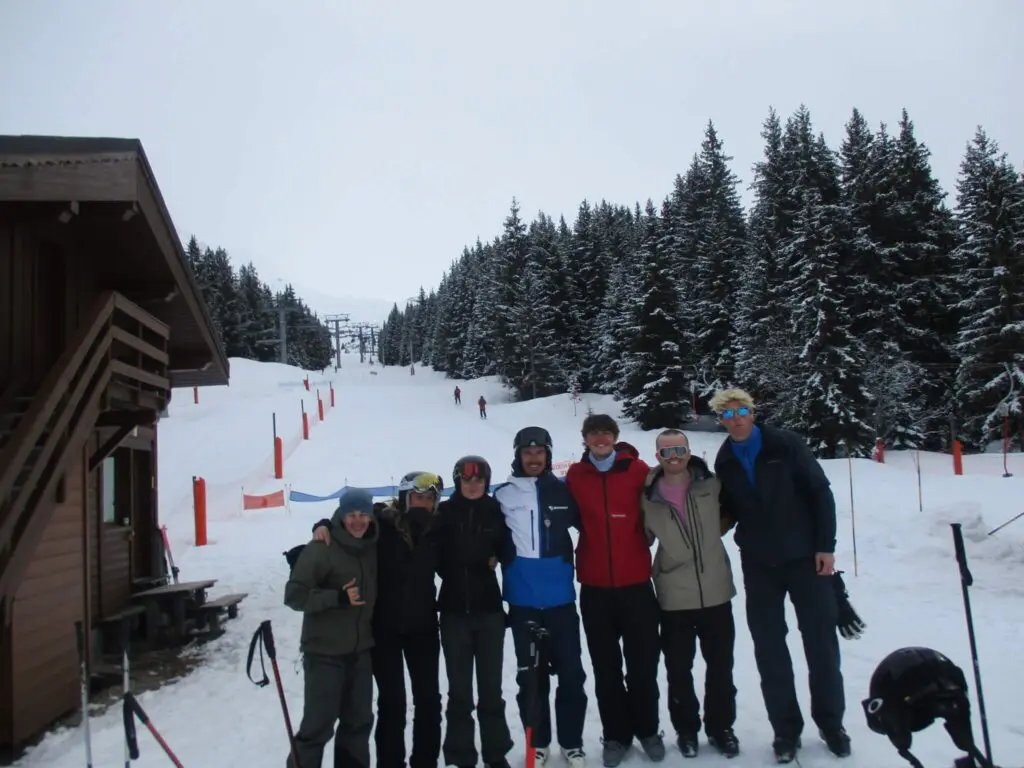
Tips for different experience levels
Whether you’re a seasoned skier or completely new to snow sports, a gap year ski season can be tailored to your ability. Here is some advice for different experience levels:
If you’re a beginner (Limited Experience)
- Yes, you can do a ski season. Many gap year programs cater to complete beginners.
- Instructor courses exist that train you from scratch to certification in one season.
- Entry-level work is accessible (e.g., cleaning, kitchen work, hotel/chalet help), especially with no ski or job experience.
- Tip: Keep an open mind toward less glamorous jobs—they get you into the resort and offer time on the slopes.
- Take lessons using staff discounts; progress is fast when you ski regularly.
- Choose beginner-friendly resorts with good ski schools and lots of green/blue runs.
- Goal: Start the season as a novice, end it as a confident skier or even an instructor.
If you’re an intermediate skier/boarder
You already handle blue and some red runs—this gives you flexibility.
Options include:
- Instructor training: Level 1 courses typically require solid intermediate skills.
- Work & ski combo: Evening jobs (like bar work) let you ski during the day.
- Mountain jobs (e.g., liftie): Come with perks like free lift passes.
- Maximise ski time by balancing job type with slope access.
- Choose resorts with varied terrain so you can push your skills.
- Try new things: off-piste, avalanche training, terrain parks.
- Goal: Go from intermediate to advanced by setting challenges (e.g., moguls, carving, blacks).
If you’re an advanced or expert
Confident on blacks and off-piste? This is your playground.
Consider:
- Teaching/guiding: Get higher-level certifications (Level 2/3, ski patrol).
- Ski bum lifestyle: Maximise freeriding if budget allows—no work, just powder days.
Pick resorts with extreme terrain:
- Europe: Chamonix, La Grave
- North America: Jackson Hole, Whistler
- Japan: Deep powder, mellow terrain
- Consider back-to-back seasons (e.g., Europe then New Zealand) to chase winter year-round.
- Invest in gear: touring skis, avalanche kit, etc., especially for backcountry.
- Goal: Make the most of your ability—tick off big lines, level up park skills, and maybe never want to leave.
What does a gap year ski season include?
Professional ski instructor training (6–10 Weeks)
The first part of your ski gap year typically involves intensive ski or snowboard training, often through a recognised programme such as BASI. This phase covers technical development, teaching methodology, and on-mountain safety.
Resort work experience (12–16 Weeks)
Once qualified, you’ll transition into a working role. Typical jobs include ski instructing, chalet jobs, hospitality, or customer service, where you’ll earn real-world experience in a vibrant, fast-paced resort setting.
Cultural immersion and personal growth
Living in mountain towns exposes you to European cultures, languages, cuisine, and customs, helping you grow as a global citizen.
Gap year ski course options and qualifications
BASI (British Association of Snowsport Instructors) pathway
BASI qualifications are internationally recognised and widely respected. Level 1 and 2 certifications typically span a full season.
>>Explore our BASI Level 1 and BASI Level 2 Courses
International certification options
Other pathways include CSIA (Canada), NZSIA (New Zealand), and PSIA (USA). These provide regional mobility for those considering a skiing gap year beyond Europe.
Specialised training modules
Some programs include avalanche safety, freestyle coaching, adaptive skiing, or snowboard-specific qualifications.
Benefits of BASI level 1 & 2 qualifications beyond the ski industry
- Academic Recognition & Formal Qualifications
SCQF accreditation
- BASI Level 1 is aligned with SCQF Level 6 (8 credit points), and Level 2 with SCQF Level 7 (12 credit points).
- These correspond to A-Level or Advanced Higher standards, validated by the University of Edinburgh.
- Having these qualifications on your CV showcases 100–120+ hours of learning and is respected by employers and academic institutions.
UCAS points
- BASI Level 1 provides 7 UCAS points per discipline (up to 35 total), giving a competitive edge in university applications.
- Though Level 2 doesn’t carry UCAS points, its SCQF Level 7 standing is equivalent to an A-Level, which can still be highlighted.
European & international recognition
- BASI’s SCQF levels align with the European Qualifications Framework (EQF):
- Level 1 = EQF 4
- Level 2 = EQF 5
- Level 1 = EQF 4
- This alignment makes your qualifications easily understood across Europe and can facilitate credit transfer or course exemptions in fields like sports coaching or outdoor education.
2. Transferable skills and career advantages
Communication & teaching
- Instructors are trained to explain complex techniques in simple, adaptable ways.
- Enhances public speaking, clarity, and audience-specific communication, applicable in education, coaching, customer service, and sales.
Analytical thinking & problem solving
- Involves analysing ski technique, diagnosing issues, and creating solutions.
- Builds critical thinking and diagnostic skills, valuable in consulting, operations, or training roles.
Patience, adaptability & customer service
- Teaches how to support learners of all types under pressure or in tough conditions.
- Develops empathy, emotional intelligence, and professionalism – useful in hospitality, retail, healthcare, or client services.
Leadership & responsibility
- Instructors are responsible for group safety and experience, often making decisions under pressure.
- Builds risk management, accountability, and leadership, key in supervisory, outdoor leadership, and management roles.
Teamwork & collaboration
- Despite individual teaching, instructors work within a tight-knit ski school team.
- Encourages peer learning, cooperation, and positivity, vital for workplace culture in any industry.
Confidence & resilience
- The instructor journey involves public performance, exams, real-world setbacks, and adapting on the fly.
- Fosters self-belief, constructive response to feedback, and a growth mindset.
3. Global experience & life skills
International mobility
- BASI qualifications are valid in many countries, enabling work and travel abroad.
- Promotes cultural adaptability, independence, and language skills.
Professional networking
- Builds lifelong connections with peers across the global ski community.
- These networks can support future career changes, travel, or entrepreneurial ventures.
Broader appeal to employers
- Employers increasingly value life experience and initiative.
- The combination of structured training, international exposure, and soft skills from BASI courses enhances any CV – even for non-ski careers.
Investment and financial considerations
Gap year ski course costs breakdown
| Cost Element | Approx. Range (GBP) |
| Instructor Training (Level 1 & 2) | £5,500 – £7,500 |
| Accommodation (full season) | £2,500 – £4,000 |
| Lift Pass | £600 – £1,200 |
| Equipment Rental/Purchase | £500 – £1,200 |
| Travel & Insurance | £500 – £1,200 |
| Total Estimated Investment | £9,600 – £14,900 |
Earning potential during work phase
Instructing or working in a resort post-qualification can bring in up to £3,000–£6,000, depending on role, country, and employer.
Financing your gap year ski season
Options include personal savings, educational grants, sponsorships, or working part-time before departure.
Preparing for your gap year ski season
Skills and fitness requirements
You don’t need to be an expert skier, but good physical fitness and a willingness to learn are essential. Pre-season training is highly recommended.
Essential preparation steps
- Choose a reputable training provider
- Secure travel insurance
- Apply for working holiday visas if needed
- Book flights early
- Attend pre-departure briefings
What to pack and equipment needs
- Quality ski jacket and pants
- Thermal base layers
- Gloves, goggles, and helmet
- Ski equipment (if not renting)
- Casual resort wear and après-ski attire
Career prospects and long-term benefits
Professional skiing career pathways
Many instructors continue into full-time seasonal careers, working across continents and progressing to higher BASI levels.
Transferable skills for future careers
Leadership, communication, teamwork, cultural awareness, and adaptability—skills honed in ski seasons—are highly valued in other sectors.
University and further education benefits
Admissions officers often recognise the maturity, independence, and real-world learning gained from a student ski year.
How New Generation makes your gap year ski season exceptional
Expert training and comprehensive support
New Generation offers coaching, ongoing mentorship, and practical career guidance tailored for aspiring instructors.
Exclusive resort partnerships
Work placements and instructor opportunities in renowned resorts like Val d’Isère, Courchevel, and La Plagne.
Complete package and peace of mind
- Training five days per week
- BASI Level 1 exam
- BASI Level 2 exam
- BASI Child Protection Module
- BASI membership fees
- Two-day outdoor first aid course
- Freestyle training
- Race training
- Off-piste coaching
- Avalanche safety training
- Off-snow theory sessions
- Video analysis
- Continental-style self-serve breakfast available five days a week
- Two-course evening meal provided five days a week
- Support team available on and off the snow
- Return transfers included
- Season lift pass provided
- Ski school shadowing experience
- Pre-course fitness program
- Employment opportunities available after the course
- Discounts on ski equipment
We take care of the details, so you can focus on learning, skiing, and growing.
Wrapping up
A gap year ski season offers a dynamic, enriching experience, blending adventure with professional growth. Whether in the French Alps, Austrian après-ski, or Swiss resorts, it provides unmatched opportunities to learn, work, and explore.
Ready to take the next step? Get in touch with our team to find out more.
